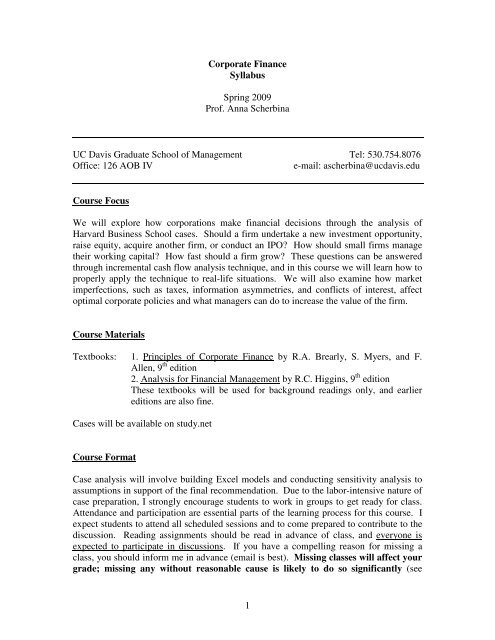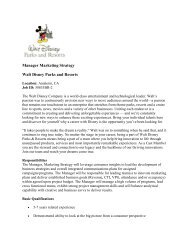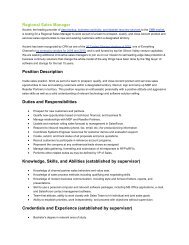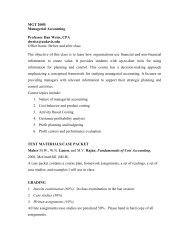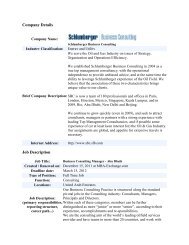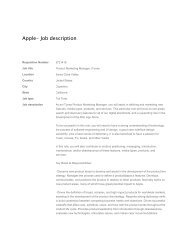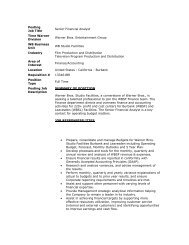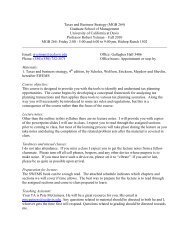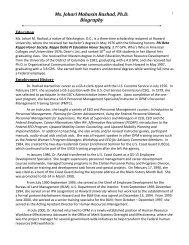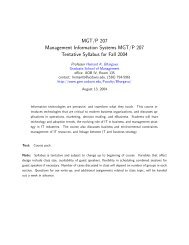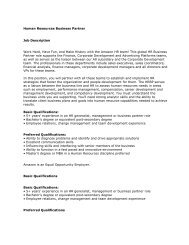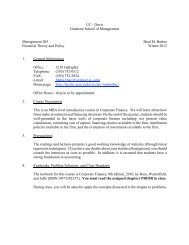1 Corporate Finance Syllabus Spring 2009 Prof. Anna Scherbina UC
1 Corporate Finance Syllabus Spring 2009 Prof. Anna Scherbina UC
1 Corporate Finance Syllabus Spring 2009 Prof. Anna Scherbina UC
- No tags were found...
You also want an ePaper? Increase the reach of your titles
YUMPU automatically turns print PDFs into web optimized ePapers that Google loves.
<strong>Corporate</strong> <strong>Finance</strong><strong>Syllabus</strong><strong>Spring</strong> <strong>2009</strong><strong>Prof</strong>. <strong>Anna</strong> <strong>Scherbina</strong><strong>UC</strong> Davis Graduate School of Management Tel: 530.754.8076Office: 126 AOB IVe-mail: ascherbina@ucdavis.eduCourse FocusWe will explore how corporations make financial decisions through the analysis ofHarvard Business School cases. Should a firm undertake a new investment opportunity,raise equity, acquire another firm, or conduct an IPO? How should small firms managetheir working capital? How fast should a firm grow? These questions can be answeredthrough incremental cash flow analysis technique, and in this course we will learn how toproperly apply the technique to real-life situations. We will also examine how marketimperfections, such as taxes, information asymmetries, and conflicts of interest, affectoptimal corporate policies and what managers can do to increase the value of the firm.Course MaterialsTextbooks: 1. Principles of <strong>Corporate</strong> <strong>Finance</strong> by R.A. Brearly, S. Myers, and F.Allen, 9 th edition2. Analysis for Financial Management by R.C. Higgins, 9 th editionThese textbooks will be used for background readings only, and earliereditions are also fine.Cases will be available on study.netCourse FormatCase analysis will involve building Excel models and conducting sensitivity analysis toassumptions in support of the final recommendation. Due to the labor-intensive nature ofcase preparation, I strongly encourage students to work in groups to get ready for class.Attendance and participation are essential parts of the learning process for this course. Iexpect students to attend all scheduled sessions and to come prepared to contribute to thediscussion. Reading assignments should be read in advance of class, and everyone isexpected to participate in discussions. If you have a compelling reason for missing aclass, you should inform me in advance (email is best). Missing classes will affect yourgrade; missing any without reasonable cause is likely to do so significantly (see1
participation grading scheme below). If you absolutely need to miss a class, please letme know ahead of time, and I will, most likely, ask you to submit written answers to casequestions prior to the missed class and evaluate your participation based on this writeup.ParticipationClass participation is a very important part of the learning process in this course. A majorpart of your final grade (40%) will be based on an assessment of the quality of yourcontributions to class discussions.QuizzesQuizzes will comprise of several multiple-choice questions and will be computer-based.Basic knowledge of all course material covered prior to the quiz will be tested. Studentsare free to consult their notes, textbooks, and the internet and will have one hour tocomplete each quiz.Final Team ProjectThe class will be assigned a case to solve and each group will prepare a detailed writtencase analysis report.Office HoursOffice hours are held by appointment.EvaluationFinal grades will be computed as:Individual participation 40%Quizzes 20%Final Team Project 40%2
The course is comprised of six modules:COURSE SCHEDULEModule 1: Financial statements, pro forma forecasting, and working capitalmanagementRecommended reading:1. R.C. Higgins, Analysis for Financial Management, Chapters 1 through 42. R.A. Brealey, S. Myers and F. Allen, Principles of <strong>Corporate</strong> <strong>Finance</strong>,Chapters 29 and 30Module 2: Time value of money, capital investment valuation, cash flow recipeRecommended reading:1. R.C. Higgins, Analysis for Financial Management, Chapter 72. R.A. Brealey, S. Myers and F. Allen, Principles of <strong>Corporate</strong> <strong>Finance</strong>,Chapters 2 and 3Module 3: Cost of capitalRecommended reading:1. R. A. Brealey, S. Myers and F. Allen, Principles of <strong>Corporate</strong> <strong>Finance</strong>,Chapters 8, 9, and 10Module 4: Valuation ratiosRecommended reading:1. R.C. Higgins, Analysis for Financial Management, Chapter 9Module 5: Capital structure and taxesRecommended reading:1. R. A. Brealey, S. Myers and F. Allen, Principles of <strong>Corporate</strong> <strong>Finance</strong>,Chapters 18 and 19Module 6: <strong>Corporate</strong> acquisitions and new equity issuancesRecommended reading:2. R. A. Brealey, S. Myers and F. Allen, Principles of <strong>Corporate</strong> <strong>Finance</strong>,Chapters 16, 32, and 333
LIST OF CASES:In this course, we will analyze the following cases (quizzes may be taken in any one-hourperiod during the week that follows the session under which the quiz is listed):Session 1:• Butler Lumber CompanySession 2:• Toy World, Inc.• Quiz #1Session 3:• Ginny’s Restaurant: An Introduction to Capital Investment ValuationSession 4:• Ocean Carriers• Quiz #2Session 5:• Partners HealthcareSession 6:• Cost of Capital at Ameritrade• Quiz #3Session 7:Session 8:• Eskimo Pie Corporation (Abridged)• Debt Policy at UST Inc.Session 9:• Pharmacyclics: Financing Research & Development• Quiz #4Session 10:• Radio One, Inc.4
CASE QUESTIONS:Module 1Session 1Case: Butler Lumber CompanyCase Questions:1. How well is Butler Lumber doing? Why?2. What has been the company’s financial strategy? Why does Mr. Butler haveto borrow so much money to support this profitable business? Has he beenmanaging his company’s cash flow wisely?3. Do you agree with his estimate of the company’s loan requirements? Howmuch will he need to borrow to finance his expected expansion in sales in1991 (assume sales volume of $3.6 million)? How much will he need overthe next several years?4. Would you urge Mr. Butler to proceed with, or to reconsider, his anticipatedexpansion plans?Session 2Case: Toy World, Inc.Case Questions:1. Should Mr. McClintock adopt the level production plan? Among otherrelevant factors, consider the following:a. The likely savings.b. The amount and timing of additional required funds. (To get anestimate, use pro forma income statements and balance sheets, NOT acash budget.)c. The pattern of liabilities.d. Risks to the various parties involved.Module 2Session 3Case: Ginny’s Restaurant: An Introduction to Capital Investment ValuationCase Questions: Please complete the questions contained in the Ginny’s Restaurant case.Session 4Case: Ocean CarriersCase Questions:Ocean Carriers uses a 9% discount rate.1. Do you expect daily spot rate to increase or decrease next year?5
2. What factors drive average daily hire rates?3. How would you characterize the long-term prospects of the capesize dry bulkindustry?4. Should Ms. Linn purchase the $39M capesize? Make two differentassumptions. First, assume that Ocean Carriers is a US firm subject to 35%taxation. Second, assume that Ocean Carriers is located in Hong Kong, whereowners of Hong Kong ships are not required to pay any tax on profits madeoverseas and are also exempted from paying any tax on profit made on cargouplifted from Hong Kong.5. What do you think of the company’s policy of not operating ships over 15years old?Module 3Session 5Partners HealthcareCase questions:1. Based on what we have done so far in class, must it be that the required return(discount rate) of any asset be related to its risk? Could it be that some assetswith high standard deviations of return rationally have low expected returns?2. Suppose that there are two assets: A and P. Assume that asset P has astandard deviation of returns of 20% per annum. You invest faction x or yourwealth in asset A and (1-x) in asset P. Suppose that x is in the rage 0-3%.a. How does the risk of the portfolio change with x if asset A is riskless?b. How does the risk of the portfolio change with x if asset A is risky,with a standard deviation of 50% p.a., but with a zero correlation withasset P?c. How does the risk of the portfolio change if, instead of zero, asset Ahas a correlation of 0.6 with asset P?d. How does the risk of the portfolio change if asset A is perfectlycorrelated with asset P and has a standard deviation of 30%?Do the same for x in the range of 3%-50%. For small x, why are the answers similar for(a) and (b), and also (c) and (d), but not for large x?Session 6Cost of Capital at AmeritradeCase questions:1. What factors should Ameritrade management consider when evaluating theproposed advertising program and technology upgrades? Why?2. How can the Capital Asset Pricing Model be used to estimate the cost ofcapital for a real (not financial) investment decision?6
3. What is the estimate of the risk-free rate that should be employed incalculating the cost of capital for Ameritrade?4. What is the estimate of the market risk premium that should be employed incalculating the cost of capital at Ameritrade?5. In principle, what are the steps for computing the asset beta in the CAPM forthe purposes of calculating the cost of capital for a project?6. Ameritrade does not have a beta estimate because the firm has been publiclytraded for only a short time period. Exhibit 4 provides various choices ofcomparable firms. What comparable firms do you recommend as theappropriate benchmarks for evaluating the risk of Ameritrade’s plannedadvertising and technology investments?7. Using the stock price and returns data in Exhibits 4 and 5, and the capitalstructure information in Exhibit 3, calculate the asset betas for the comparablefirms.8. How should Joe Ricketts, the CEO of Ameritrade, view the cost of capital youhave calculated?Module 4Session 7Eskimo Pie Corporation (Abridged)Case questions:1. What is your estimate of the per share value of Eskimo Pie using thediscounted cash flow approach?Hints:a. Begin by estimating the cash flows anticipated in 1992. You shouldbuild your cash flows off the updated forecasts on page 5 of the caseinstead of using the information in Exhibit 6.b. The working capital listed in the balance sheet data portion of Exhibit1 equals current assets less current liabilities, and therefore includes asubstantial amount of cash. Because the business involves so littlemanufacturing or retailing, it is reasonable to assume that workingcapital (A/R plus Inventory less A/P) is negligible.c. You can also reasonably assume that capital expenditures equaldepreciation.d. Choose your comparable companies from Exhibit 8, and follow theprocedure we used in Ameritrade to estimate the cost of capital forEskimo Pie.e. Use your cash flow estimate for 1992 along with your estimate of agrowth rate and cost of capital in a growing perpetuity formula toestimate the discounted cash flow value of Eskimo Pie.7
2. How does the value you estimated using the discounted cash flow approachcompare to the market value of the comparable companies?Hints:a. Use multiples of sales and cash flowsb. Consider multiples implicit in Nestle’s offer for Eskimo Pie3. Why would Nestle want to acquire Eskimo Pie? Is Eskimo Pie worth more toNestle than it worth as a stand-alone company?4. As an advisor to Reynolds, would you recommend the sale to Nestle or theproposed initial public offering?Module 5Session 8Debt Policy at UST Inc.Case Questions:1. What are the primary business risks associated with UST Inc.? What are theattributes of UST Inc.? Evaluate from the viewpoint of a bondholder.2. Why is UST Inc. considering a leveraged recapitalization after such a longhistory of conservative debt policy?3. Should UST Inc. undertake the $1 billion recapitalization? Calculate themarginal (or incremental) effect on UST’s value, assuming that the entirerecapitalization is implemented immediately (January 1, 1999).a. Assume 38% tax rate.b. Prepare a pro-forma income statement to analyze whether UST will beable to make interest payments.c. For the basic analysis, assume the $1 billion in new debt is constantand perpetual. Should UST alter the new debt via a differential levelor change in the amount of debt through time?4. UST Inc. has paid uninterrupted dividends since 1912. Will recapitalizationhamper future dividend payments?Module 6Session 9Pharmacyclics: Financing Research & DevelopmentCase Questions:5. Why is Pharmacyclics (PCYC) considering an equity issue in March 2000?Why $60 million? What factors should Dr. Richard Miller consider indeciding whether to raise equity?8
6. What is your forecast of after-tax cash flows for PCYC through 2002assuming Xcytrin and Lutrin are approved? How would your forecast changeif the drugs where not approved?7. Compare these cash flows to PCYC’s liquid assets (cash and investments thatcan be easily converted to cash). As of March 2000, how many future yearsof funding does PCYC have?8. Repeat this analysis for 1994. What funding strategy is apparent in PCYC’spre-IPO financing? Why would the managers of PCYC want to follow thisstrategy? Would its investors also want PCYC to follow this strategy?9. Forecast after-tax cash flows for PCYC through the expiration of the four drugpatents. Use a tax rate of 35% and the following additional assumptions inyour analysis:• For Lutrin: 50% probability of FDA approval in 2002.• For Antrin: 30% probability of FDA approval in 2004. If Antrin isapproved by the FDA, its contribution to pre-tax income would be $191million in FY05 and peak at $281 million in FY06.• For Optrin: 30% probability of FDA approval is 2004. If Optrin isapproved by the FDA, its contribution to pre-tax income would be $25million in FY05, $40 million in FY06, and peak at $50 million in FY07.• For all drugs: Patent protection for these drugs ends ten years after FDAapproval. Upon patent expiration, analysts expected revenue to fall at aperpetual rate of 20% per year (for example, if revenue is $1.00 prior topatent expiration, the pattern of revenues after patent expiration is forecastat $0.80, $0.64, $0.51, etc.).10. What is the appropriate discount rate to value the after-tax cash flowsfollowing approval in 2002? Is that rate also appropriate prior to approval?11. What is the appropriate terminal value?12. What is the value of PCYC? What is your estimate of value per share?13. How sensitive is your estimate of per share value to your assumption aboutprice per treatment and off-label use of Xcytrin? What other assumptions areimportant?Session 10Radio One, Inc.Case Questions:1. Why does Radio One want to acquire 12 urban stations from Clear ChannelCommunications in the top 50 markets along with the nine stations inCharlotte, NC, Augusta, GA, and Indianapolis, ID? What are the benefits andrisks?2. Are the cash flow projections for the potential new markets reasonable?3. What are the incremental after-tax cash flows for 2001 through 2004 for thepotential new markets? Use the information in Exhibit 9 along with yourestimate of capital expenditures, working capital, and taxes to estimate theafter-tax cash flows.9


